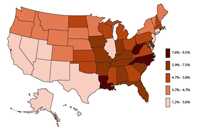Key Findings from the Manuscript, entitled: “State-Based and Demographic Variation in Parent-Reported Medication Rates for Attention-Deficit/Hyperactivity Disorder, 2007-2008”

Attention-deficit/hyperactivity disorder (ADHD) is a common neurobehavioral disorder of childhood, and medication is the single-most effective treatment for this disorder. ADHD is usually first diagnosed in childhood and often lasts into adulthood. ADHD causes problems in how well children do in school, in their ability to make and keep friends, and in their ability to function in society.
Researchers from the Centers for Disease Control and Prevention (CDC) used parent-reported data from the 2007-2008 National Survey of Children’s Health (NSCH) to estimate the percentage of children ages 4-17 taking medication for ADHD, nationally and by state. The results were published in Preventing Chronic Disease. You can find the article here. The findings from this article are summarized in the following text.
Main Study Findings
- 2.7 million of the 4.1 million US school-aged children with ADHD were taking medication for treatment, based on parent report
- Boys were more likely than girls to be taking ADHD medication, at every age
- State-based rates of ADHD medication treatment among those with ADHD ranged from 33% in Nevada to 79% in Mississippi
- The lowest rates of medication usage were documented in 5 Western states (Nevada, California, Alaska, Hawaii, and New Mexico)
- The highest rates of medication usage were documented in 5 Southern states (North Carolina, Louisiana, West Virginia, Arkansas, and Delaware)
- The state-based variation in ADHD medication treatment supports reports by the Food and Drug Administration of uneven distribution of common ADHD medication, contributing to ADHD medication shortages in certain states
Click on this map for more details

ADHD and CDC’s Work
CDC monitors the prevalence of disruptive behavioral disorders and ADHD, in particular, through the use of national survey data and by conducting community-based studies. The estimates that result from these monitoring activities have been used to assess the impact of the disorder over time and have been used to inform investigations of adverse events among children medicated for ADHD.
CDC also conducts community-based studies to better understand the impact of ADHD and other mental and behavioral health conditions. The Project to Learn about ADHD in Youth (PLAY) study methods have been implemented in four community sites. Information from the PLAY study helps us better understand ADHD and other mental and behavioral disorders, as well as the needs of children and families living with these conditions.
The National Resource Center on ADHD, a program of Children and Adults with Attention-Deficit/Hyperactivity Disorder (CHADD), is a CDC supported Public Health Practice and Resource Center. Their web site has links to evidence-based information for people with ADHD and their families. The National Resource Center operates a call center with trained, bilingual staff to answer questions about ADHD. The number is 1-800-233-4050.
More Information
To learn more about ADHD and CDC’s work in the area of ADHD, please visit https://www.cdc.gov/ncbddd/adhd/
Reference
- Visser, S. N., S. J. Blumberg, et al. (2013). “State-based and Demographic Variation in Parent-reported ADHD Medication Rates, 2007-2008.” Preventing Chronic Disease 10: 20073.
- Page last reviewed: October 17, 2016
- Page last updated: September 30, 2014
- Content source:


 ShareCompartir
ShareCompartir